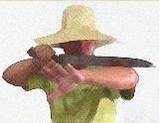
 Lameco Eskrima is the system of Filipino martial arts founded by the late Edgar Sulite based on his training and experience with various Philippine Martial Arts masters, with heavy influence from Jose Caballero and Antonio Ilustrisimo.
Lameco Eskrima is the system of Filipino martial arts founded by the late Edgar Sulite based on his training and experience with various Philippine Martial Arts masters, with heavy influence from Jose Caballero and Antonio Ilustrisimo. The word Lameco is actually a combination of words which are the three basic ranges of combat involved in the study and practice of Lameco Eskrima - Largo, Medio and Corto (Long, Middle, close).
Edgar trained with martial arts masters who included Leo Gaje of Pekiti-Tirsia, Jose Cabellero of De Campo Uno-Dos-Tres Orehenal, Jesus Abella of Modern Largos, Antonio Illustrisimo of Kali Illustrisimo and many others.
In 1981, he moved to Manilla to train under Grandmaster Antonio Ilustrisimo. After relocating to the United States on June 30, 1989, he became instructor to Dan Inosanto and Larry Hartsell.
He suffered from complications arising from a stroke and died on April 10, 1997.
Lameco Eskrima TrainingOne of the characteristics of Filipino martial arts is the use of weapons from the very beginning of training. The primary weapon is a rattan stick, also called a cane or baston. These sticks vary in length from about 26 inches to as much as 38 inches in length or more. The weapons can vary in weight and thickness depending on the preference of the practitioner.
Lameco uses Double and single Stick, Double and single Dagger, Stick and Dagger, Sword, Staff, Handkerchief, and Empty Hands. Lameco Eskrima is a synthesis of five major and six minor systems of Eskrima.
Lameco employs training drills called Laban Laro (Play Fighting). Laban Laro allows the escrimador to come as close to real combat as possible without injury. It is also designed to get an uncountable number of repetitions in a short period of time.
Through his constant efforts for developing new training innovations, Edgar devised unique armor for the hands and forearms that allowed practitioners to safely train more realistically.

No comments:
Post a Comment